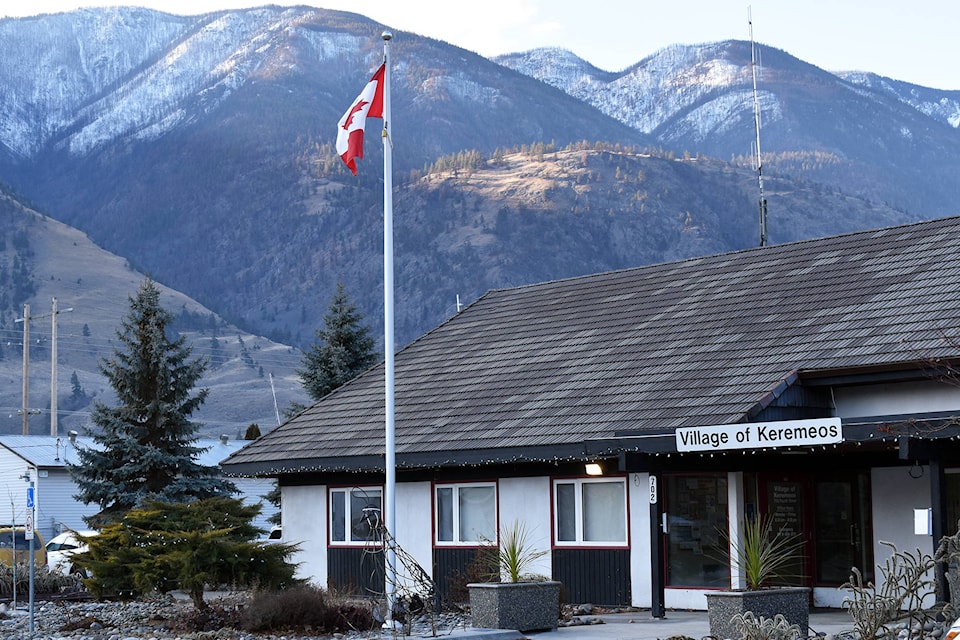By Brennan Phillips
Keremeos Review Staff
Keremeos’ village council met on Monday for the first meeting of the new year. The council focused on the first draft of the village’s strategic plan for 2020 as one of the main subjects of the session.
One of the main aspects addressed in the plan for the year will be revising the village’s Official Community Plan. The last time the OCP was reviewed was in April, 2013.
“Some of the initial work, including some of the outlining, has already been done for the plan, so it will not be a full rewrite from the base up,” said Marg Coulson, the village’s chief administrative officer. “When it is finished will be as time permits at the RDOS.”
The OCP governs how the Village of Keremeos plans to develop the land within their borders, covers zoning bylaws in the village, and how the village sees the community growing in the future. The OCP is one of the documents used by the Agricultural Land Commission when ruling on whether to let a property leave the Agricultural Land Registry.
As part of the strategic plan, the village is also looking to continue several initiatives that were started in 2019, including work on updating flood mapping and mitigation strategies. That work may be delayed, as the village is currently awaiting outside work to be completed before they can proceed.
“The flood mapping and mitigation is waiting for Geo BC to do the LIDAR mapping, which was planned to be done in 2019,” Coulson added as an update to the agenda at the council session. “The village can’t proceed without the mapping, and so we may need to extend that.”
Mayor Bauer also added the welcome news that the Ministry of the Environment was already looking at the third phase of the Village’s Liquid Waste Management plan. With the ministry’s approval, the village would be able to go forward with its plans to upgrade the wastewater treatment plant to handle expansion of the sewage system in Keremeos for current users and future residents and expansions.
Read More: Keremeos looks forward to 2020
The usage of the village building as a demonstration site for the FireSmart neighbourhood initiatives is also continuing into 2020. The cacti around the village offices, as well as flammable trees, were removed from the area around the building as part of this.
Also up at the council meeting was how Keremeos’ efforts to go green are gaining speed, with a 144 per cent increase in electric vehicles recharging in the village.
Back in Oct. 2015, the village installed an electric vehicle charging station outside the village offices.
Since then, the charging station has seen steady growth year over year, with a record-high number of users in August 2019.
“We are part of getting away from carbon emissions and making the planet a little greener,” said Mayor Manfred Bauer at Monday’s council meeting.
Since the charging station was installed, 996 vehicles have used it to recharge, saving over 12,000 kilograms of CO2 and 5310 litres of gasoline. The charging station that the village operates is capable of charging any and all-electric vehicles currently on the road, from Teslas to Leafs.
The village operates the charging station in partnership with BC Hydro, who reimburse the village for the electricity costs for the vehicles that charge up at the station.
In 2016, the first year after the station was installed and record-keeping began, a total of 116 cars used the station to recharge. In 2019, there were 517, with 108 in August alone.
Read More: Keremeos residents discuss politics over coffee with the mayor
While the current numbers may not be particularly stunning, the council sees the growth as a sign that times are changing.
“What I see, not just in B.C., but in other provinces and countries, there is not yet that price level that entices people to change over to electric vehicles. They are still very pricey, and the range is not there yet,” said Bauer. “It’s a barrier that will be overcome with eventually, and that’s why I think the numbers are still fairly low. The numbers will come, and we’re still looking at more infrastructure. Maybe a second charging station, because it will come, it’s just a matter of time.”
The final issue, separate from the strategic plan proposed at the council session was the subject of the ongoing development of the pocket park across from the village building.
Work on the park started in 2018, and this year was absent from the outlined initiatives in the strategic plan, as the project no longer has any planned expenditures. Work on the project has been slowed for various reasons, particularly the flooding and fires in 2018.
“Development of the park is a matter of manpower, and it will be done as there is time. All that remains to be done is the pouring of the pad, moving the little quail from the front of this building into the middle of that pad, laying out the rest of the turf, and then they’re going to be building a little pergola,” said Coulson. “All the trees have been purchased, everything is ready to go. “
The draft of the strategic plan is now planned to be reviewed, with the finalized version to appear before the council with amendments at a later date. The revisions to the OCP will include a period of public input, also to be scheduled at a later date.
To report a typo, email: editor@pentictonwesternnews.com.
<>@PentictonNews
newstips@pentictonwesternnews.com
Like us on Facebook and follow us on Twitter.
